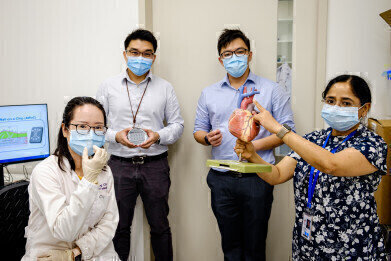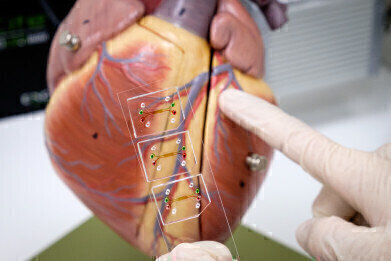-
 (L_R) PhD student Su Chengxun holding the prototype ‘arterial wall-on-a-chip’, NTU Assistant Professor Hou Han Wei, Assistant Professor Dalton Tay and TTSH Senior Consultant Associate Professor Rinkoo Dalan, who is holding a heart model. Credit NTU Singapore
(L_R) PhD student Su Chengxun holding the prototype ‘arterial wall-on-a-chip’, NTU Assistant Professor Hou Han Wei, Assistant Professor Dalton Tay and TTSH Senior Consultant Associate Professor Rinkoo Dalan, who is holding a heart model. Credit NTU Singapore -
 A microfluidic 3D model of the human blood vessel has been developed by NTU and TTSH scientists to study atherosclerosis in blood vessels and coronary arteries. Credit NTU Singapore
A microfluidic 3D model of the human blood vessel has been developed by NTU and TTSH scientists to study atherosclerosis in blood vessels and coronary arteries. Credit NTU Singapore
News & Views
Novel 3D Model Aids Vascular Disease Research
Sep 06 2021
A 3D model of the human artery blood vessel wall has been developed by a team of scientists and clinicians from Nanyang Technological University, Singapore (NTU Singapore) and Tan Tock Seng Hospital (TTSH)
The ‘arterial wall-on-a-chip’ will help researchers study atherosclerosis, a condition in which cholesterol and inflammatory cells form a plaque on blood vessel walls that results in the vessels narrowing and constricting blood flow, leading to cardiovascular diseases.
The team used this new microfluidic chip, which mimics the cross-section of an arterial wall, to study the effects of oxidative stress on blood vessels, which is usually caused by conditions such as high cholesterol (hyperlipidemia) and inflammation.
The study [1] found that as oxidative stress increase, smooth muscle cells which are found in the middle layer of arteries move inwards, causing inflammation on the endothelial layer on the interior of the artery.
This was the first time the above effects have been observed in 3D, since previous studies on atherosclerosis have been carried out using animal models, or two-dimensional (2D) cell cultures, which do not fully reveal the interactions between smooth muscle cells and the endothelial layer.
Senior author of the study, Assitant Professor Hou, also a faculty member in NTU’s Lee Kong Chian School of Medicine, said: “Our new ‘wall-on-a-chip’ model could help clinicians better understand the fundamental biology and conditions of vascular dysfunction when atherosclerosis starts, and the different processes involved in its progression, so that new strategies for early intervention of atherosclerosis can be developed.”
The team also observed that Vitamin D and a common diabetes medication, metformin, helped to prevent certain key processes leading to the plaque formation. This suggests that their 3D model can be potentially used to screen and test new drug molecules that can treat or prevent atherosclerosis.
The team now plans to conduct more experiments to further improve the modelling using their new chip and to use it to study other vascular diseases, in addition to atherosclerosis at varying stages of development.
More information online
1. A novel human arterial wall-on-a-chip to study endothelial inflammation and vascular smooth muscle cell migration in early atherosclerosis, published in Royal Society’s Lab on a Chip, Issue 12, 21 June 2021.
Digital Edition
Lab Asia 31.2 April 2024
April 2024
In This Edition Chromatography Articles - Approaches to troubleshooting an SPE method for the analysis of oligonucleotides (pt i) - High-precision liquid flow processes demand full fluidic c...
View all digital editions
Events
May 05 2024 Seville, Spain
InformEx Zone at CPhl North America
May 07 2024 Pennsylvania, PA, USA
May 14 2024 Oklahoma City, OK, USA
May 15 2024 Birmingham, UK
May 21 2024 Lagos, Nigeria




.jpg)












